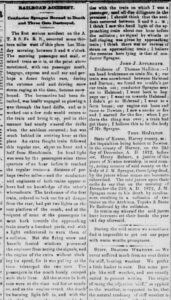by Kristine Schmucker, Archivist/Curator
Railroad work was dangerous. Working with heavy machinery meant the possibility that fingers, and other limbs could get caught and severely damaged. Sometime the work resulted in loss of life.
The first major train accident that occurred in Harvey County happened early in the morning of December 23, 1872 about thirteen miles west of Newton.
The eastbound train, consisting of a locomotive, a dozen freight cars, a baggage-express mail car and a passenger coach, became stuck in drifting snow. The engine was uncoupled to break through the drifts, returning to pull the train as progress with the snow was made.
An extra freight train had departed Hutchinson about an hour and a half behind the regular train. Passengers on the first train reported seeing the headlight of the second train for three quarters of an hour. The brakeman from the first train put two lights on the rear platform and another approximately 100 yards from the train to alert the second train to the first one’s position.
Flying snow and frosted windows in the engine cab prevented the engineer of the freight train (2nd train) from seeing the warning lights and “without slackening its speed, it telescoped the two rear cars.”
“Barely Escaped with Their Lives”
The passengers in the first train “barely escaped with their lives.” The conductor of the second train, J. M. Sprague, was in the mail room trying to warm himself. Upon impact, he was thrown down with the red-hot, coal-burning stove landing on top of him. He burned to death and was the only fatality. Another employee, Campion, was in his bunk at the time but was pulled out of the car by two passengers.
The first engine went to Newton to report the accident and send a relief crew to go out to the wreck. Many of the passengers were coatless in the extreme cold. Both the coach car and the baggage-mail car were completely destroyed when the wood construction caught fire due to the coal stoves.
The accident was made worse by the wood construction of the cars and the use of coal stoves. Accidents like this one were common in the 1870s and 1880s. When steam heat replaced the coal stoves, the danger of the stoves catching on fire was diminished. In 1906, all steel cars were introduced which eliminated the threat of this type of accident.
Sources
- Newton Kansan, 26 December 1872.
- Stagner, L.E., July 1983 in Newton, Kansas #1 Santa Fe Rail Hub 1871-1971, by L.M. Hurley, (Newton: Mennonite Press) 1985.

